Diners may order takeout and delivery more often these days, but they continue to make it clear that in-restaurant dining remains an important and valued experience in the so-called new normal.
And while many consumers necessarily upped their cooking-at-home skills over the past couple of years, the collective appetite for eating at restaurants remains strong: In its 2023 “State of the Restaurant Industry” report, the National Restaurant Association revealed that 84% of consumers say going to a restaurant with family and friends represents a better use of their leisure time than cooking and cleaning up at home. Late last year, in its “What’s Hot 2023 Forecast,” the NRA reported that pent-up demand for in-restaurant experiences is strong, with 70% of its survey respondents noting customer desire to gather on-premises.
When they do gather in restaurants, that whole notion of “experience” is now more critical than ever. And during their restaurant visits, guests experience few things more intimately than the items they directly interact with on the tabletop. Plateware, glassware, other serving vessels, flatware and accessories all help define the up close and personal experience for diners, both visually and tactilely.
Curating and purchasing tabletop items demands a sharp focus on aesthetics, of course, but myriad other factors come into play. It’s all about finding the right balance of form, function, affordability and availability.
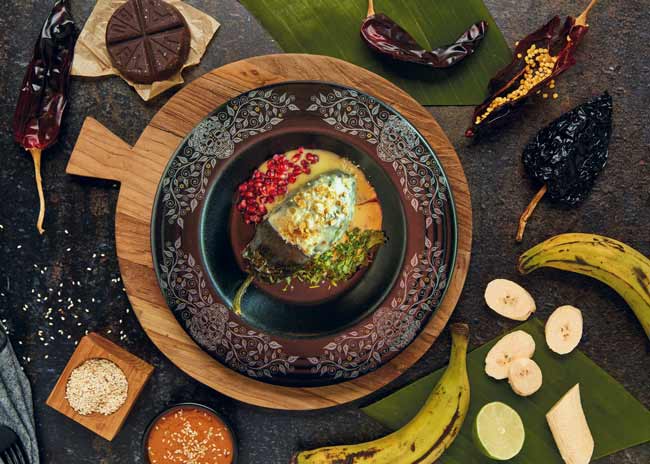 Barrio Queen’s team makes frequent scouting trips to Mexico for ideas and inspiration, then brings ideas back to its U.S. supplier partners to source similar items that work in high-volume environments. Photo courtesy of BBQ Holdings Inc.
Barrio Queen’s team makes frequent scouting trips to Mexico for ideas and inspiration, then brings ideas back to its U.S. supplier partners to source similar items that work in high-volume environments. Photo courtesy of BBQ Holdings Inc.
Individualize the Experience
At new Cleveland hot spot Jaja, one of four foodservice venues opened last year by Harbor Bay Hospitality in the INTRO mixed-use development, a carefully curated collection of tabletop items supports the brand’s sophisticated, feminine and highly eclectic vibe. The items are considered as much a contributor to creating the desired transportive experience for guests as lighting, materials, colors and decor accessories, according to Andrew Carroll, director of corporate operations for Harbor Bay Hospitality.
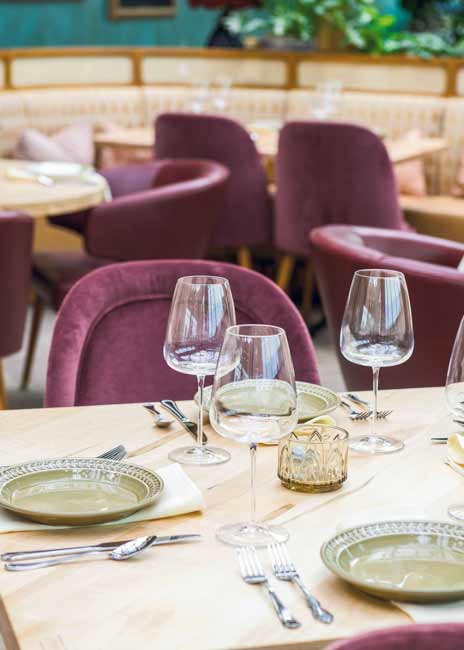 At Jaja, almost all dishes are served on different plateware styles. “We have a very eclectic mix of tabletop items that are both elevated and approachable,” Carroll says. “We do a lot of small plates, and almost everything comes out on a different plate. We worked closely with the interior designers in making our selections and gathered pieces from all over — Italy, Mexico, Turkey, even retail home goods stores — to get the collection and look that we wanted. A big fail for us would be if the dining experience ended at the table, where you can have amazing food and service, but the dishes and glassware are nothing special. A lot of chefs like to plate on white, but we have a No Standard White Porcelain rule for Jaja; everything has color and/or pattern.”
At Jaja, almost all dishes are served on different plateware styles. “We have a very eclectic mix of tabletop items that are both elevated and approachable,” Carroll says. “We do a lot of small plates, and almost everything comes out on a different plate. We worked closely with the interior designers in making our selections and gathered pieces from all over — Italy, Mexico, Turkey, even retail home goods stores — to get the collection and look that we wanted. A big fail for us would be if the dining experience ended at the table, where you can have amazing food and service, but the dishes and glassware are nothing special. A lot of chefs like to plate on white, but we have a No Standard White Porcelain rule for Jaja; everything has color and/or pattern.”
Harbor Bay takes more traditional tabletop sourcing approaches for its other three operations at INTRO, which include Edda, a coffee roastery and cafe with a clean, Scandinavian aesthetic; Pioneer, an elevated rustic sports bar; and Truss, a 300-seat rooftop events venue. In part, that’s because they’re higher volume than the 82-seat (plus patio) Jaja and require more consistent supplies for replenishment. But it’s also because Carroll has been able to find plenty of brand-appropriate core options through local commercial foodservice equipment and supplies dealers. Even in those cases, however, he layers in carefully sourced specialty items to help support each concept’s unique identity.
At Edda, for example, which features a minimalistic and neutral design, Carroll sourced a signature mug from Japan that the operation uses for its drip and pour-over coffees. “They’re beautiful, dark amber glass — our pop of color. Everything else is either white porcelain or clear glass,” he notes. “Supply chain issues made it tough to get them, but it came down to having conversations with company representatives in San Francisco and Japan and ultimately getting them air shipped directly. You do end up having to completely pivot away from some things, but sometimes, with a little extra legwork, you can make it work and get what you really want.”
Gilles Brochard, senior business development manager at TriMark R.W. Smith in San Diego, also sees customers increasingly looking for tabletop items that enable them to create such layered, individualized aesthetics. “The trends have really steered toward the retail market,” he notes. “No. 1: Operators don’t want what everybody else has. No. 2: They want everything to be eclectic, unique and almost purpose-built; in some cases, it seems, that means a dedicated plate or bowl for every dish. They don’t want the old standard five-piece place setting with matching plate, salad plate, bowl, etc. They look to retail and social media for ideas, and that forces us to look there, too, and then see where we can find similar products that will perform well for them in commercial settings.”
 At ANIMAE, a San Diego steakhouse with Asian influences, tabletop selections are both chef- and design-driven, with the entire effect being dramatic, comfortably upscale and brand-supportive.
At ANIMAE, a San Diego steakhouse with Asian influences, tabletop selections are both chef- and design-driven, with the entire effect being dramatic, comfortably upscale and brand-supportive.
Brochard recently worked with celebrity chef Brian Malarkey’s multi-concept restaurant group on the opening of ANIMAE, a high-end, Asian-influenced steakhouse where Japanese A5 wagyu beef serves as a signature offering. The tabletop section process, he says, was very chef-driven, with Malarkey in many cases assigning one serving vessel per menu item. “He very much wanted to have everything showcased in its own presentation,” Brochard says. “It called for a lot of pieces of china and other serving dishes, and it all had to fit with the very high-end concept and decor while still being practical and durable.”
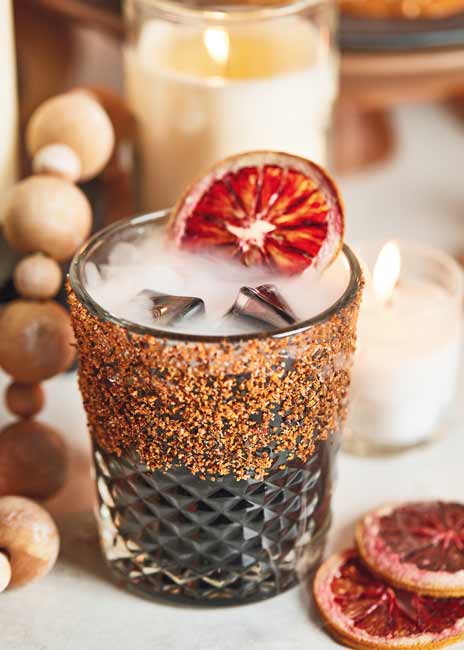 Each specialty cocktail at Barrio Queen has its own dedicated glassware. Photo courtesy of BBQ Holdings Inc.Chris Puffer, co-owner/managing partner at the Puffer Malarkey Collective, spearheads design for all of the company’s restaurants. He says every item for the tabletop was chosen specifically to highlight the food, support ease of service and bolster the overall brand aesthetic. And while ANIMAE, with its $135-per-person ticket average, fits squarely into the fine-dining category, its menu features Asian street-food influences, creating what Puffer describes as a “high-low” experience. That ethos extends to the tabletop as well, where the team has walked away from fussy, traditional fine-dining settings to embrace a simpler, more casual approach.
Each specialty cocktail at Barrio Queen has its own dedicated glassware. Photo courtesy of BBQ Holdings Inc.Chris Puffer, co-owner/managing partner at the Puffer Malarkey Collective, spearheads design for all of the company’s restaurants. He says every item for the tabletop was chosen specifically to highlight the food, support ease of service and bolster the overall brand aesthetic. And while ANIMAE, with its $135-per-person ticket average, fits squarely into the fine-dining category, its menu features Asian street-food influences, creating what Puffer describes as a “high-low” experience. That ethos extends to the tabletop as well, where the team has walked away from fussy, traditional fine-dining settings to embrace a simpler, more casual approach.
“I’m tired of the old traditions such as always setting wine glasses on the tables, which then have to be cleared and repolished, and of having a smaller salad fork and larger dinner fork,” Puffer says. “They just add a lot of extra and unnecessary mechanics. In all our restaurants, we now have only nice, high-quality, durable water glasses pre-set on the tables. Less is more. The room looks clean and orderly, and there are fewer arms and elbows reaching across the tables to take things away that aren’t in use.”
For ANIMAE, where most of the plates are black or gray or white ceramic, Puffer chose crystal, stemmed water glasses to lend a more upscale ambiance. Forks — one size for everything, except shellfish — are matte black, which he feels contrast nicely with the tabletops and coordinate with the dark ceramics.
“A water glass is really important,” Puffer adds. “It’s something that people are going to pick up again and again throughout the meal. It should be well made and durable, but also a little special. For general silverware, I like to have a decent weight, but I don’t care if it’s stamped. I just need it to hold up, look good and be reasonably priced because silverware somehow seems to always disappear and need replenishing.”
Another important piece on ANIMAE’s tables is what Puffer calls a share plate. Like pre-set wine glasses and small salad forks, he eschews traditional bread and butter plates as unnecessary, opting instead for 8-inch black ceramic plates. “We don’t do tapas, but we do encourage sharing and passing of plates, so we use a share plate. Placed between the knife and fork setting, we top it with a taupe-colored linen napkin and wooden chopsticks. We felt that wooden chopsticks were more practical and fit the street-food, high-low aspect of the concept well. They have our logo on them, and we ordered a full pallet directly from China.”
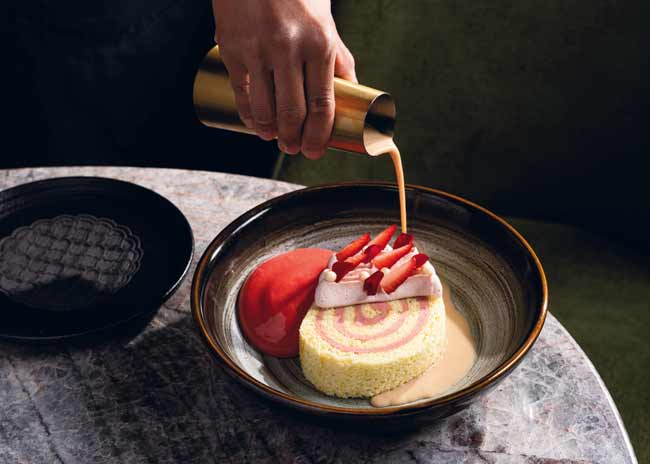 Instagram-worthy aesthetics, durability and performance come together in ANIMAE’s mix of tabletop items. Photos courtesy of James Tran
Instagram-worthy aesthetics, durability and performance come together in ANIMAE’s mix of tabletop items. Photos courtesy of James Tran
Balance Wow Factor, Practicality
Brochard adds that finding the right balance of uniqueness, aesthetics and practicality for ANIMAE, as for most accounts, required give and take. Malarkey and Puffer wanted distinctive pieces and initially hoped to source many items made by a local potter, for example, but lead times were a crucial issue. “That handmade product has, at minimum, a four- to six-week lead time,” Brochard points out. “That’s not practical for a busy restaurant. We were able to whittle selections down to a few custom items but found higher-production pieces with a similar look that we stock, that they can easily get replenishments for and that hold up better. It has paid off because they end up having to order those pieces just about every other week, which would have been a nightmare with long lead times.”
At BBQ Holdings’ concept Barrio Queen, a seven-unit, upscale-casual Mexican restaurant brand based in Phoenix, director of supply chain Shane Hetman says finding that essential balance of practicality, availability and brand-supporting personality is mission-critical. There, tabletop items play a crucial role in creating an authentic Mexican experience for guests.
Hetman and her team routinely make scouting trips to Mexico for inspiration and ideas. “We want guests to feel transported, like they could be sitting at a restaurant in Mexico,” Hetman notes. “So, we go there often to look at what’s new, what’s different, what’s hot and try to bring some of those elements in to our restaurants. If we find something we like, we then work with our partners here in the U.S., mostly Wasserstrom and Edward Don, to find something similar that would work for us. And we always get samples. Samples are absolutely critical, and we put them through the wringer. We might love the look of something, but before bringing it in, we put it through service tests, through the dishwasher, etc. Everything has to work operationally.”
On its tables, Barrio Queen uses a colorful variety of plates and serving vessels, from white-and-blue-patterned Mexican-style pottery — a signature look the concept has used for years — to white porcelain, to ceramics in black, blues and greens, to rustic wooden serving boards. Hetman says the brand has trended toward more color and more varied styles of glassware, and it recently introduced authentic lava-rock molcajete serving bowls to its permanent tabletop collection.
“We brought the molcajetes in because they’re so authentic,” Hetman says. “We use them as an entree serving dish, which is very traditional Mexican style. We serve our tacos on boards, which is different than most restaurants. And we have different glassware paired to almost every specialty drink. We want our food and beverages to stand out on their own, but it’s extremely important that the glassware, plates and other serving pieces add to the experience and the authenticity. We splurge a bit on items like the molcajetes, but feel that it’s justified because of the experience it creates for our guests. Whenever we’re sourcing specialty pieces, that’s our North Star. Can they go elsewhere and get that same experience? No? OK, let’s have a conversation. We then lay out the pros and cons and determine if it makes sense for the business.”
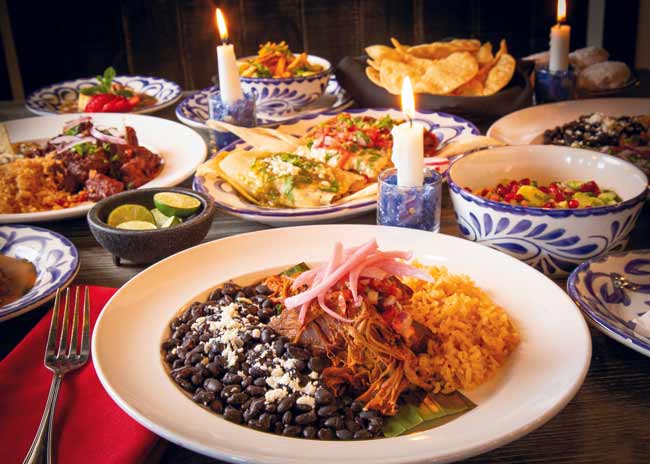 At Barrio Queen, tabletop items play a crucial role not just in aesthetics, but in creating an authentic Mexican experience for guests. Photo courtesy of BBQ Holdings Inc.
At Barrio Queen, tabletop items play a crucial role not just in aesthetics, but in creating an authentic Mexican experience for guests. Photo courtesy of BBQ Holdings Inc.
Tabletop from the Pros
“Sample, sample, sample and test. You may love it, but if it doesn’t perform or hold up, find an alternative.” — Shane Hetman, BBQ Holdings
“Do your research, talk to vendors, make sure you’re getting the best price possible on your core items. The money you save allows you to splurge on a few specialty items that really elevate the look and feel.” — Andrew Carroll, Harbor Bay Hospitality
“Train your staff how to scrape and separate dishes in the dish area. That’s huge for reducing breakage and replenishment costs. So is putting a kitchen mat on the floor in the dish pit as a landing pad.” — Chris Puffer, Puffer Malarkey Cooperative
“Matte looks fantastic out of the box and photographs beautifully. But scratches are very visible, and it doesn’t do well with grease, staining and fingerprinting. If you’re using it for one dish that you’re selling 10 of a day, maybe. But if it’s a workhorse piece, you’re likely going to have some really ugly plates in a week or less.” — Gilles Brochard, TriMark R.W. Smith




